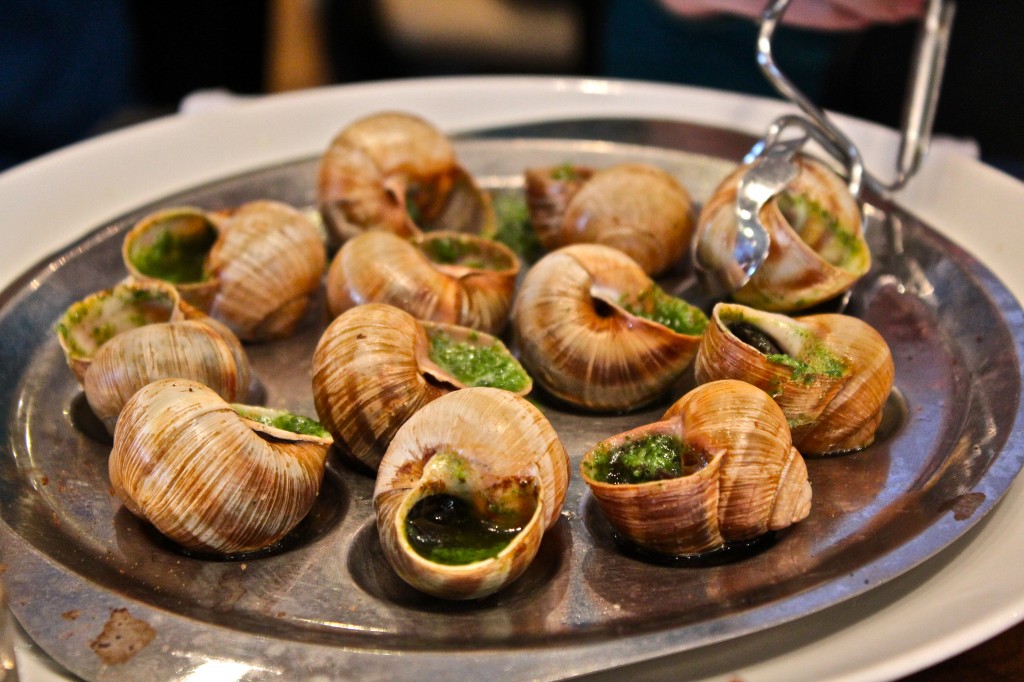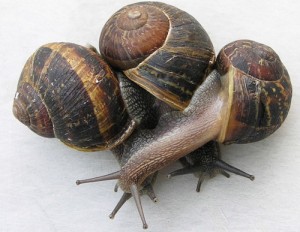Cornu aspersum
Native Range: Areas bordering the Mediterranean and Black Seas, Western Europe, and Britain
Invasive Range: In the United States and Canada, West Coast from California to British Columbia, most southeastern states, and along the East Coast north to New Jersey.
Habitat: Gardens and parks, coastal dunes, groves and hedges, between rocks. Can be found feeding on nearly anything growing in a vegetable or flower garden. Snails are mostly nocturnal but can come out on rainy days. They typically feed when temperatures are between 40°F and 70°F.
Description: Large globose shell, yellow or horn colored with chestnut spiral bands. The body is soft and slimy, brownish gray. Retracts into its shell when threatened or at rest.
The brown garden snail or European brown snail is native to the Mediterranean and western Europe as far north as Britain. Deliberately or accidentally, by the movement of plants and by hobbyists who collect snails, humans have spread it to temperate and subtropical zones around the world. Relished as edible where it’s native, the snail is regarded as a garden and agricultural pest where it has been introduced.
The earliest recorded introduction in the United States was in the 1850s in California by a Frenchman, who saw the Gold Rush as lacking in escargot. The locals had no interest in the mollusk, but it adapted well to the Mediterranean climate of California, becoming a serious pest of crops and ornamentals, especially citrus groves and vineyards. Later in the century, a member of the U.S. Fish Commission, returning from a fact-finding (and fish-finding) trip to Europe, unofficially but deliberately brought back some garden snails, which he affixed to a garden wall in Massachusetts. (The introduction, in that case, didn’t stick.) Many areas have quarantines to prevent the import of snails in container-grown plants.
The brown snail has now become naturalized in climates much different from the Mediterranean where it evolved. In temperate zones, it has gone cosmopolitan. It’s on all continents but Antarctica, and on most big islands.
They’re a pest, a delicacy, and occasionally a pet. (See, for example, The Sound of a Wild Snail Eating, by Elisabeth Tova Bailey, though this will not encourage you to eat said mollusks.) They’re considered fish by the Catholic Church, so are abstinence fare, permitted on meatless days during Lent. In Lleida, a city of Catalonia, there’s a gastronomic festival, L’Aplec del Caragol, dedicated to the garden snail.
In French cuisine, the snail is known as petit gris, served in Escargot à la Bordelaise. The French don’t consider the garden snail a nuisance at all, but a reason to spend time with the family, walking with buckets through their yards—even grassy fields—in pursuit of their prize. Invasivores and their families might follow suit.
Harvest
French cooks believe that snails gathered in the fall are tastiest, but according to author and farmer Gail Damerow, gardeners who collect snails in the spring, when damage can be greatest, find little difference in flavor. Snails are mostly nocturnal, so the most productive harvesting times are early in the evening or morning, when the yard is damp with dew. Snails will also emerge after a light rain. It’s best to use a cloth bag when collecting, so the snails can breathe.
Rearing snails for food is known as heliciculture. In a dark place, the snails are kept on dry straw or dry wood in a wire cage. Grapevine prunings are often used. During the rainy season, they come out of hibernation and release most of their mucus onto the wood or straw. Then they’re prepared for cooking. As invasivores, we encourage you to eat your snails from the wild—and to beware of snail poison. If you suspect that a neighbor is poisoning snails—do not eat them.
Recipes
Kohli Bourbouristi
Sautéed Snails
Adapted from Departures.com.
“All the Greeks eat snails every day,” wrote Galen in the second century AD. Archaeology corroborates him through shells found in ancient trash pits.
The recipe he referred to? Cooked snails as a topping for porridge or bread. The tradition continues on the island of Crete. In the hilly countryside, after rain, Cretan children gather snails flushed into the open by rainwater; the creatures are kept alive for a few days on a cleansing diet of thyme and flour, then served up stewed or fried.
Snail dishes are common in Crete, but the simply prepared bourbouristi—pronounced boor-boor-ee-stee (the word echoes the popping and hissing sounds of snails in the frying pan)—is a hallmark.
Ingredients
30 to 50 snails
½ cup Greek olive oil
1/3 cup red wine vinegar
2 sprigs rosemary
salt
Rinse 30 snails in cold water.
Sprinkle salt into a large frying pan and place it over medium heat.
Place snails in the pan with shell openings down.
Fry for 1 to 2 minutes, then add 1/2 cup of olive oil, reduce the heat to low and cook for 10 minutes.
Stir in 1/3 cup of red-wine vinegar; sprinkle with rosemary. Cover the pan and heat for 5 minutes.
Serve in the shells, with the sauce in the pan.




























